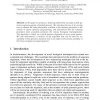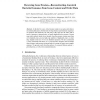99
Voted
WABI
2004
Springer
15 years 6 months ago
2004
Springer
Abstract. In this paper we propose a chaining method that can align a draft genomic sequence against a finished genome. We introduce the use of an overlap tree to enhance the state...
108
Voted
WABI
2004
Springer
2004
Springer
Reversing Gene Erosion - Reconstructing Ancestral Bacterial Genomes from Gene-Content and Order Data
15 years 6 months ago
In the last few years, it has become routine to use gene-order data to reconstruct phylogenies, both in terms of edge distances (parsimonious sequences of operations that transform...
WABI
2004
Springer
15 years 6 months ago
2004
Springer
Abstract. Genomic instabilities, amplifications, deletions and translocations are often observed in tumor cells. In the process of cancer pathogenesis cells acquire multiple genom...
100
Voted
WABI
2004
Springer
15 years 6 months ago
2004
Springer
Abstract. We give an algorithm that locally improves the fit between two proteins modeled as space-filling diagrams. The algorithm defines the fit in purely geometric terms and...
94
Voted
WABI
2004
Springer
15 years 6 months ago
2004
Springer
—In practice, one is often faced with incomplete phylogenetic data, such as a collection of partial trees or partial splits. This paper poses the problem of inferring a phylogene...
89
Voted
WABI
2004
Springer
15 years 6 months ago
2004
Springer
—The problem of reconstructing the duplication history of a set of tandemly repeated sequences was first introduced by Fitch [4]. Many recent studies deal with this problem, show...
128
Voted
WABI
2004
Springer
15 years 6 months ago
2004
Springer
Abstract. Haplotype inference problem asks for a set of haplotypes explaining a given set of genotypes. Popular software tools for haplotype inference (e.g., PHASE, HAPLOTYPER) as ...
WABI
2004
Springer
15 years 6 months ago
2004
Springer
WABI
2004
Springer
15 years 6 months ago
2004
Springer
Conserved intervals were recently introduced as a measure of similarity between genomes whose genes have been shuffled during evolution by genomic rearrangements. Phylogenetic reco...
107
click to vote
WABI
2004
Springer
15 years 6 months ago
2004
Springer
Computational heuristics are the primary methods for reconstruction of phylogenetic trees on large datasets. Most large-scale phylogenetic analyses produce numerous trees that are ...



